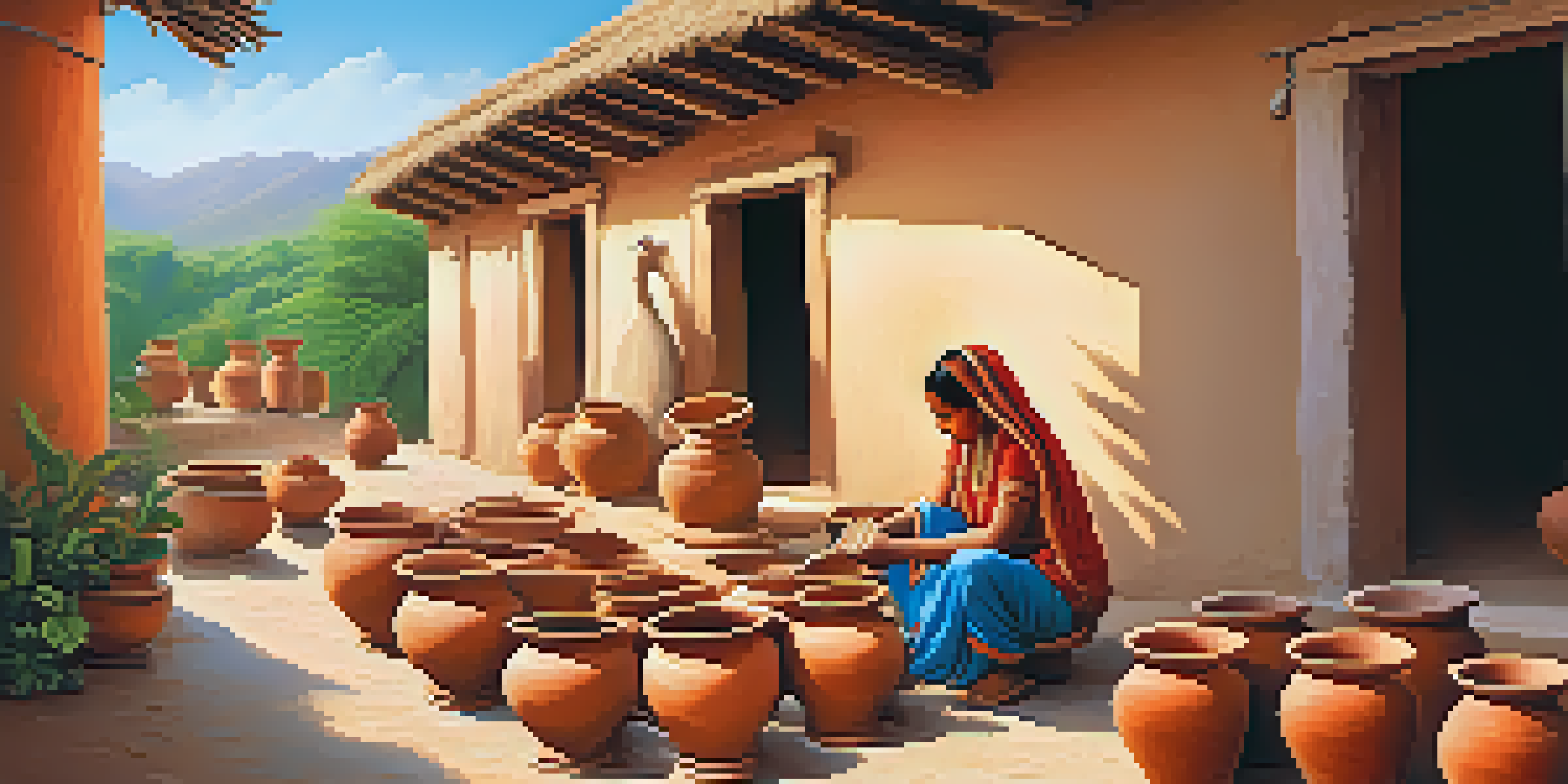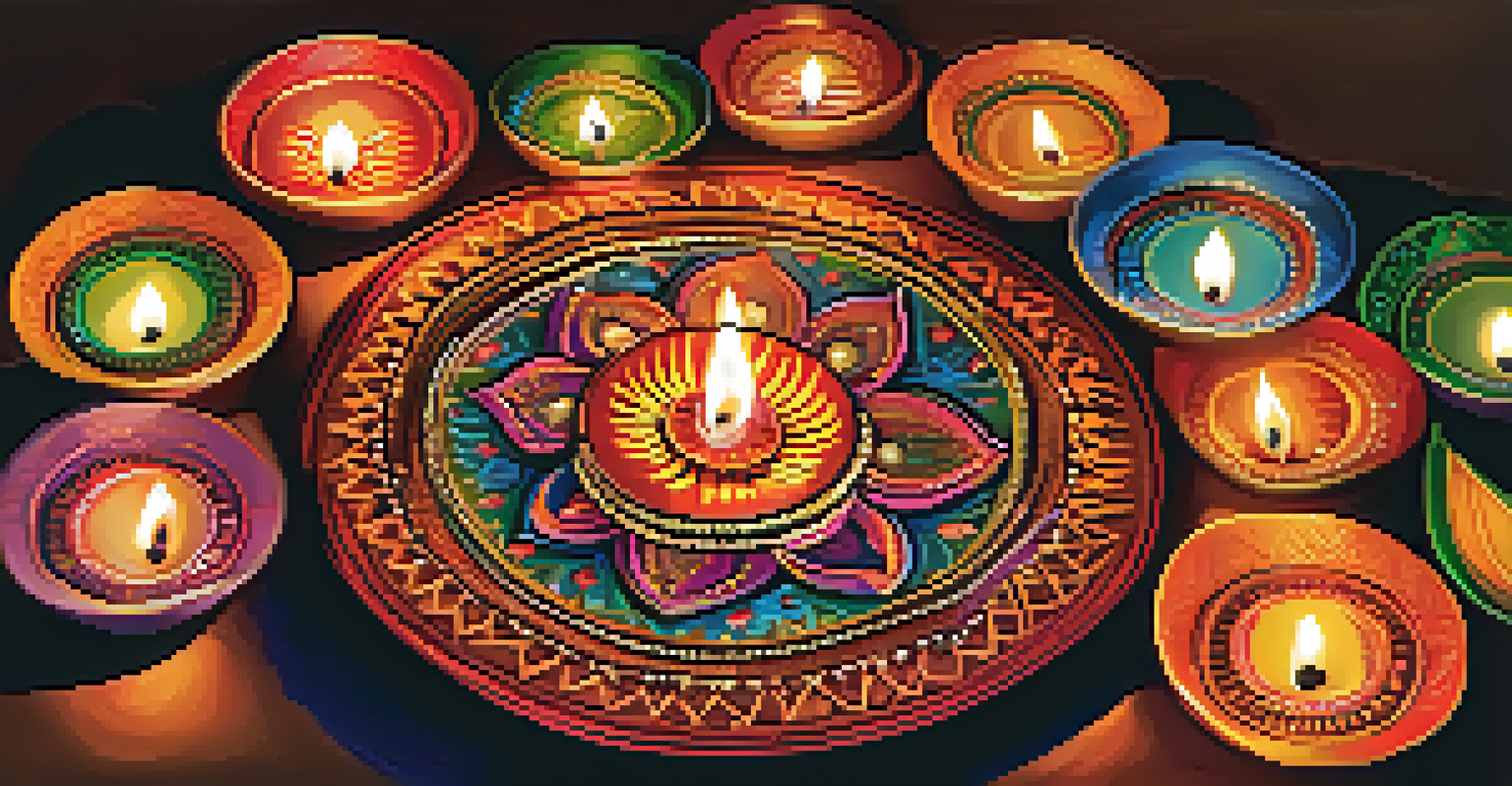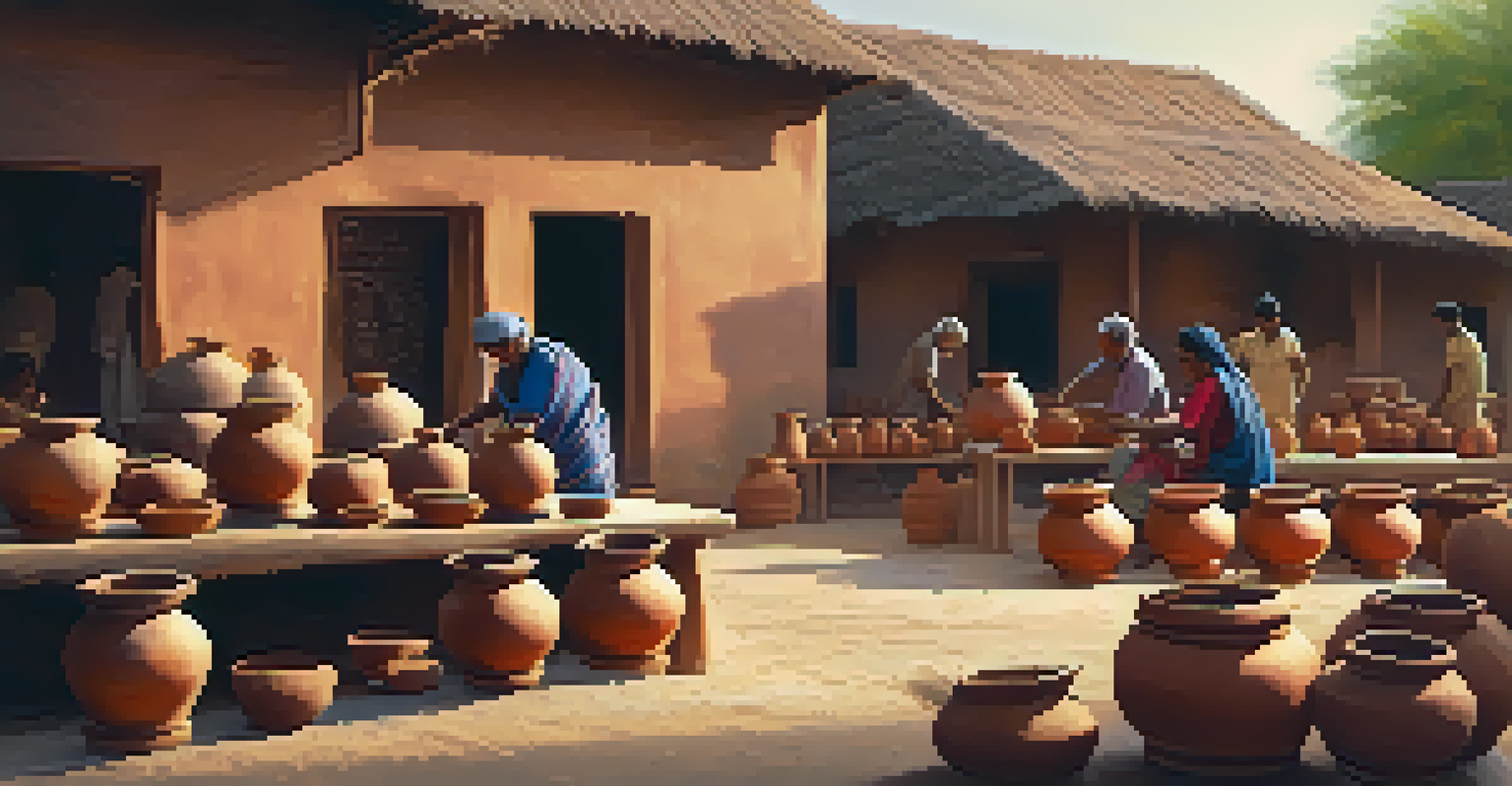The Art of Pottery: Traditional Craftsmanship in Indian Villages

Understanding the Rich History of Indian Pottery
Pottery in India dates back thousands of years, with roots in the Indus Valley Civilization. This ancient craft has evolved, yet still retains its traditional essence, reflecting the culture and lifestyle of the people. Each village often has its unique style, influenced by local resources and practices, making Indian pottery diverse and fascinating.
Pottery is the art of turning the ordinary into the extraordinary.
For instance, in the village of Kumartuli, artisans create intricate clay idols for festivals, showcasing their skills passed down through generations. This deep-rooted history not only shapes the physical form of the pottery but also its significance in various rituals and celebrations across India. Understanding this history allows us to appreciate the artistry behind each piece.
Moreover, pottery is a communal activity in many villages, where families come together to craft and celebrate the creation process. This sense of community enriches the cultural fabric of these areas, creating a bond among artisans that transcends generations.
The Traditional Techniques Used in Pottery Making
The process of traditional pottery involves several meticulous steps, each requiring skill and patience. First, artisans source high-quality clay, which is then kneaded and shaped on a potter's wheel. This wheel, often powered by foot or hand, has been used for centuries and remains a symbol of craftsmanship in Indian culture.

Once shaped, the pottery is left to dry before being adorned with unique designs. Many artisans use natural dyes and paints, which not only highlight their creativity but also connect them with their environment. For example, terracotta pieces from certain regions may feature motifs inspired by local flora and fauna, making each item a representation of its surroundings.
Rich Heritage of Indian Pottery
Pottery in India reflects a deep cultural history, showcasing diverse styles and community practices that have evolved over thousands of years.
Finally, the pottery is fired in a kiln, a process that strengthens the clay and brings out vibrant colors. This transformation from raw clay to finished product is a captivating journey that showcases the artistry and dedication of the potters.
The Role of Pottery in Indian Culture and Rituals
In Indian culture, pottery is far more than a craft; it serves practical and ceremonial purposes. From everyday utensils to ceremonial items used in weddings or festivals, pottery plays a vital role in daily life and spirituality. For instance, earthen lamps (diyas) are essential during Diwali, symbolizing light and prosperity.
Tradition is not the worship of ashes, but the preservation of fire.
Many villages also have specific pottery styles associated with particular festivals, showcasing their unique cultural significance. In some areas, clay pots are used for rituals to honor deities, emphasizing the connection between the artisans and their spiritual beliefs. This interplay between art and spirituality makes pottery a living tradition.
Moreover, the items crafted often tell stories that reflect the community's values and heritage. Each piece can carry a narrative, symbolizing traditions, beliefs, and the collective memory of the people, reinforcing their identity through generations.
Contemporary Challenges Facing Potters in Villages
Despite its rich heritage, traditional pottery faces numerous challenges today. The advent of mass-produced ceramics has overshadowed handcrafted pottery, leading to a decline in demand for artisanal products. This shift not only threatens the livelihood of potters but also risks losing unique cultural practices.
Additionally, younger generations are often drawn to urban lifestyles, leaving behind the traditional skills and knowledge. This migration creates a gap in the transmission of craftsmanship, as fewer apprentices are available to learn from the masters. As a result, many villages are witnessing a decline in the number of practicing potters.
Challenges Facing Traditional Artisans
Modern pressures, including mass production and urban migration, threaten the survival of traditional pottery and the skills of artisans.
However, some artisans are embracing innovation, blending traditional techniques with modern designs to appeal to new markets. This adaptation can help sustain their craft and ensure its survival in a rapidly changing world, proving that tradition can coexist with modernity.
The Importance of Sustainability in Pottery Practices
Sustainability plays a crucial role in pottery, particularly in an era where environmental concerns are paramount. Traditional pottery often utilizes locally sourced materials, minimizing the carbon footprint associated with transportation and production. This environmentally friendly approach aligns with the growing demand for sustainable products.
Many potters are also turning to natural glazes and dyes, which not only enhance the beauty of their creations but also reduce harmful chemicals. This shift towards eco-friendly practices reflects a broader awareness of the need to protect the environment while preserving cultural heritage.
By prioritizing sustainability, these artisans not only contribute to ecological balance but also create a niche market that values responsible craftsmanship. This connection between traditional practices and modern sustainability trends offers a promising path for the future of pottery in Indian villages.
Reviving Interest in Traditional Pottery
Reviving interest in traditional pottery is essential for keeping this craft alive. Various initiatives, such as workshops and exhibitions, are helping to educate people about the beauty and significance of handcrafted pottery. These events create opportunities for potters to showcase their work while fostering appreciation among younger audiences.
Social media platforms have also become valuable tools for artisans to share their creations and stories, reaching a global audience. By highlighting their unique skills and cultural heritage, potters can attract interest and support for their craft, sparking a renewed love for traditional pottery.
Sustainability in Pottery Practices
Emphasizing sustainable methods, many potters are adapting their techniques to create eco-friendly products that honor both tradition and the environment.
Community-driven efforts, such as collaborations with local artists and designers, can further amplify the visibility of pottery. Such partnerships not only breathe new life into the craft but also reinforce its relevance in contemporary society, ensuring that the art of pottery continues to thrive.
Conclusion: Celebrating the Art of Pottery in India
The art of pottery in Indian villages is a vibrant tapestry woven with history, culture, and craftsmanship. Each piece crafted tells a story, a reflection of the community's identity and traditions. As we celebrate this beautiful art form, it's crucial to recognize the efforts of artisans who keep these traditions alive despite modern challenges.
By supporting local potters and advocating for sustainable practices, we can help preserve this invaluable heritage for future generations. Whether it's through purchasing handcrafted items or participating in workshops, every effort contributes to the continuation of this beautiful craft.

Ultimately, the art of pottery is not just about creating functional items; it's about nurturing connections, preserving culture, and celebrating the unique artistry that defines Indian villages. Embracing this craft allows us to appreciate the rich heritage that shapes our world.